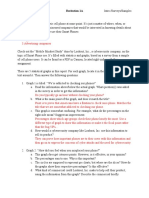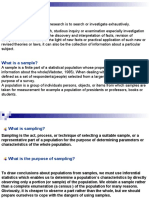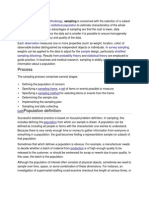Day 1 Notesheet
Uploaded by
252732Day 1 Notesheet
Uploaded by
252732Name: _________________
AP Statistics Handout: Lesson 4.1
Topics: sample vs. population, biased sampling, simple random samples (SRS)
Lesson 4.1 Guided Notes
Sample vs. Population
Census: when you collect data on every individual in the _______________________.
Sample: a _____________ of individuals from a population.
Population
It’s hard to measure everyone (population), so we take a sample
Sample and make ____________________ about the population.
Graphic courtesy of the National Center for Education Statistics
Biased Sampling
Example: Investigating College Advertisement Statistics
SW Tennessee Community College: The homepage of their website boasts: “Our overall graduation
placement rate is ______, with 91% working in their field of study.” - www.southwest.tn.edu (6/9/2020)
Population
Sample à _________
Among full-time, first-time degree or certificate-seeking students
who entered in 2010/2011, Source: IPEDS (2020)
Bias: a study flaw that leads to _______________________ and/or inaccurate estimates.
Undercoverage: When part of the population has a __________________ of being included in a sample.
-Leads to bias.
-Ex: excluding the students who didn’t graduate.
Material adapted from the Skew The Script curriculum (skewthescript.org)
Lessons made available under a Creative Commons Attribution-NonCommercial-ShareAlike 4.0 License
(https://creativecommons.org/licenses/by-nc-sa/4.0)
2
Rogers State University (Oklahoma): In a recent report*, the University found that about 75% of
graduates were pursuing another degree or had found full-time employment by their final semester.
The same report shows that the response rate to the University’s questions/surveys was only 20%.
Nonresponse: When individuals chosen for a sample don’t respond.
-Leads to bias if these individuals ___________ from respondents.
Population
Sample à _______________
Grads without jobs probably
respond _______________.
*Employment and Continuing Education for Graduating Students 2017-2019 AY 3-Year Aggregation
(downloaded 6/9/2020 from https://www.rsu.edu/about/accountability-academics/student-outcomes/)
Question: How could bias in the sampling method have affected the graduate study/employment rate
estimate from Rogers State University?
When writing about sampling bias…
1. Identify the population and the sample
2. Explain how the sampled individuals might __________________ the general population
3. Explain how this leads to an _________________________________.
Model Response:
“Graduates who didn’t find post-grad employment may be ashamed, making them ______________ to
respond to the survey. Therefore, this sampling method may include a lower proportion of unemployed
graduates than in the full population. This produces an _________________ of the true percentage of
_____ graduates who are actually starting full-time work.”
Important: These categories of bias can overlap. On an FRQ, if you’re unsure,
Types of selection bias ________ try to use one of these vocab terms. Instead, just describe the bias,
-Undercoverage bias how it arises, and whether it leads to an under or overestimate.
-Nonresponse bias
-Voluntary response bias: Occurs when a sample is composed of _______________, who may differ
from individuals who don’t choose to volunteer.
Ex: You want to study heart rate during exercise. You recruit volunteers to run a mile and then
measure their pulse. The few insane people in our society who actually like to run are the ones
who volunteer, so they’re healthier on average than the population à bias
Types of survey bias
-Question wording bias: When survey questions are confusing or leading.
Ex: “Which show do you prefer: Diners, Drive-In, and Dives, hosted by the incredibly talented,
funny, and interminable mayor of Flavortown / chef Guy Fieri or Iron Chef hosted by the boring
Alton Brown?
-Self-reported response bias: When individuals inaccurately report their own traits.
Ex: I report being able to bench-press 350 lbs.
Material adapted from the Skew The Script curriculum (skewthescript.org)
Lessons made available under a Creative Commons Attribution-NonCommercial-ShareAlike 4.0 License
(https://creativecommons.org/licenses/by-nc-sa/4.0)
3
Simple Random Samples (SRS)
In order to avoid bias, you must _____________ sample.
Simple Random Sample (SRS): a sampling method in which every possible group of individuals in the
population has an __________________ of being selected.
Example: COVID-19 and Sampling
When COVID-19 spread to NYC, the city only provided tests to people who ____________________.
Some infected people don’t show symptoms. So, the sampling method led to an ________________ of
the number of people infected. It was __________.
Instead: We could have ______________________ the NYC population, tested those who were
sampled, and gotten an __________________ of the number of people infected.
Question: Describe how you would implement a simple random sample (SRS) of 1,000 NYC residents to
test for COVID.
When describing how to perform an SRS:
1. Assign each individual in the population a number 1 – N (population size).
2. Use a random number generator to obtain n (sample size) numbers, skipping repeats.
3. Sample the individuals whose numbers were generated
Model Response:
“Assign every individual in NYC an integer _______ (where N is the population size of NYC). Use a
random number generator to obtain 1,000 integers between 1 – N, __________________________.
Administer the COVID test to the 1,000 individuals whose numbers were selected.”
Lesson 4.1 Discussion
Discussion Question: During World War II, a statistician by the name of Abraham Wald was asked to
help the British air force decide where to put extra armor on their planes. They gave him charts of the
bullet holes in planes that were wounded in fighting but made it back safely to England. An example is
shown below, with each dot representing places hit by bullets.
Using the chart, on what part of a new plane would you
recommend they put extra armor? Choose from the
options below and give a statistical reason for your choice.
Options: A)Nose B)Wings C)Body D)Engine E)Tail
Image courtesy of Professor Joseph Blitzstein (i.e. the best stats prof in the country).
See his “Harvard Thinks Big” talk on this problem: https://youtu.be/dzFf3r1yph8
Material adapted from the Skew The Script curriculum (skewthescript.org)
Lessons made available under a Creative Commons Attribution-NonCommercial-ShareAlike 4.0 License
(https://creativecommons.org/licenses/by-nc-sa/4.0)
You might also like
- 00 Unit 3 Collecting Data Student Notes 2023-24No ratings yet00 Unit 3 Collecting Data Student Notes 2023-2410 pages
- Author(s) Prerequisites Learning Objectives: Inferential StatisticsNo ratings yetAuthor(s) Prerequisites Learning Objectives: Inferential Statistics8 pages
- Test Bank For Statistics Concepts and Controversies 9th Edition Moore Notz 1464192936 9781464192937100% (36)Test Bank For Statistics Concepts and Controversies 9th Edition Moore Notz 1464192936 978146419293736 pages
- Chapter 5: Selecting Research ParticipantsNo ratings yetChapter 5: Selecting Research Participants5 pages
- Math 7 Module 10 and 11 Practice ProblemsNo ratings yetMath 7 Module 10 and 11 Practice Problems45 pages
- Notes For In-Class Activity 1: The Basic ParadigmNo ratings yetNotes For In-Class Activity 1: The Basic Paradigm15 pages
- Chapter 1 - Sampling and Experimental DesignNo ratings yetChapter 1 - Sampling and Experimental Design9 pages
- Introduction To Statistics. An Overview of StatisticsNo ratings yetIntroduction To Statistics. An Overview of Statistics11 pages
- Collecting Data Sensibly: Chapter Is VERY Important!No ratings yetCollecting Data Sensibly: Chapter Is VERY Important!52 pages
- Unit 3 - Sampling and Experimental Design New - Read-OnlyNo ratings yetUnit 3 - Sampling and Experimental Design New - Read-Only44 pages
- Process: Statistics Survey Methodology Statistical PopulationNo ratings yetProcess: Statistics Survey Methodology Statistical Population14 pages
- Statistics Chapter 4 Notes Section 4.1 Designing Studies: Definition: Population and SampleNo ratings yetStatistics Chapter 4 Notes Section 4.1 Designing Studies: Definition: Population and Sample6 pages
- Chapter 1 - Concepts and Terminology - 2019No ratings yetChapter 1 - Concepts and Terminology - 201911 pages
- ECMT 1010: Introduction To Economic StatisticsNo ratings yetECMT 1010: Introduction To Economic Statistics27 pages
- Uneducated Guesses: Using Evidence to Uncover Misguided Education PoliciesFrom EverandUneducated Guesses: Using Evidence to Uncover Misguided Education Policies2/5 (1)
- Resilience of The Tower Test To Response BiasNo ratings yetResilience of The Tower Test To Response Bias9 pages
- Azin - Holz - & - Goldiamond - 1961 Response Bias in Questionnaire RNo ratings yetAzin - Holz - & - Goldiamond - 1961 Response Bias in Questionnaire R3 pages
- Lesson 8. Writing The Report Survey Field Report Laboratory Scientific Technical. English For Academic and Professional Purposes. 2021-20No ratings yetLesson 8. Writing The Report Survey Field Report Laboratory Scientific Technical. English For Academic and Professional Purposes. 2021-2052 pages
- The Impact of Website Interface Design Quality On User SatisfactionNo ratings yetThe Impact of Website Interface Design Quality On User Satisfaction2 pages
- The Ability of Internal Auditors To Identify Ethical DilemmasNo ratings yetThe Ability of Internal Auditors To Identify Ethical Dilemmas10 pages
- Reaction Time To Emotional and Neutral WordsNo ratings yetReaction Time To Emotional and Neutral Words19 pages
- TCM Employee Commitment Survey Academic Package 2004No ratings yetTCM Employee Commitment Survey Academic Package 200416 pages
- Developing A Questionnaire - PPT DownloadNo ratings yetDeveloping A Questionnaire - PPT Download8 pages
- Essentials of Marketing Research 6th Edition Babin Solutions Manual 1100% (67)Essentials of Marketing Research 6th Edition Babin Solutions Manual 121 pages
- Lab Report On Effects of Emotional and Neutral Words On Response TimeNo ratings yetLab Report On Effects of Emotional and Neutral Words On Response Time12 pages
- Topic 6: Quantitative Research-Survey Research INo ratings yetTopic 6: Quantitative Research-Survey Research I18 pages
- 2017 - A Critique of Response Bias in The Tourism, Travel and Hospitality ResearchNo ratings yet2017 - A Critique of Response Bias in The Tourism, Travel and Hospitality Research9 pages
- Cross-Sectional and Longitudinal Survey ResearchNo ratings yetCross-Sectional and Longitudinal Survey Research21 pages
- Frings-2015-Journal of Applied Social PsychologyNo ratings yetFrings-2015-Journal of Applied Social Psychology10 pages
























































































